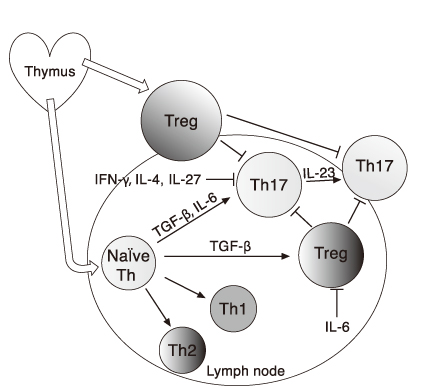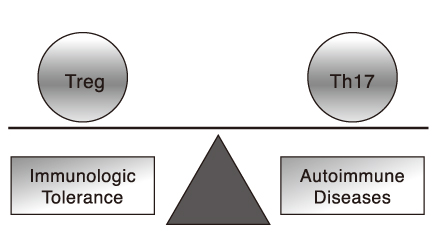 |
 |
- Search
| J Korean Med Assoc > Volume 52(7); 2009 > Article |
Abstract
The immune system maintains the integrity of our bodies by warding off intruding microorganisms, but by sustaining tolerance to our own tissues. The immunologic tolerance is established by several layers of safeguards, including physical elimination of self-reactive lymphocytes during their development in the central lymphoid organs, anergy induction in autoreactive lymphocytes before their emigration to the periphery, or production regulatory T lymphocytes that suppress the activation, proliferation, and differentiation of various effector cells. The major regulatory T lymphocytes display their phenotype as CD4+CD25+Foxp3+ and constitute about 10% of the peripheral T lymphocytes. Even with these safeguards, the immunologic tolerance sometimes fails and generates autoimmune diseases. Scientists studying the pathogenesis of autoimmune diseases pay particular attention to a CD4+ T lymphocytes subset, Th17 lymphocytes, distinct from Th1 and Th2. Th17 produces diverse proinflammatory cytokines including IL-17 and TNF-α. Th17 and these cytokines are causatively associated with many episodes of autoimmune diseases. Accumulated data reveal the critical role of Th17 cells in the pathology of autoimmunity and portray them as an important target in the treatment of various autoimmune diseases. In this article, we will describe the main characteristics of regulatory T cells and Th17 cells and their cellular and molecular mechanisms of protective or destructive functions, respectively.
References
1. Pulendran B, van Driel R, Nossal GJV. Immunological tolerance in germinal centres. Immunol Today 1997;18:27-32.
2. Sakaguchi S. Regulatory T cells: key controllers of immunologic self-tolerance. Cell 2000;101:455-458.
3. Carneiro-Sampaio M, Coutinho A. Tolerance and autoimmunity: lessons at the bedside of primary immunodeficiencies. Adv Immunol 2007;95:51-82.
4. Cantor H, Shen FW, Boyse EA. Separation of helper T cells from suppressor T cells expressing different Ly components. II. Activation by antigen: after immunization, antigen-specific suppressor and helper activities are mediated by distinct Tcell subclasses. J Exp Med 1976;143:1391-1400.
5. Sakaguchi S, Takahashi T, Nishizuka Y. Study on cellular events in posTthymectomy autoimmune oophoritis in mice. II. Requirement of LyT1 cells in normal female mice for the prevention of oophoritis. J Exp Med 1982;156:1577-1586.
6. Sakaguchi S, Sakaguchi N, Asano M, Itoh M, Toda M. Immunologic self-tolerance maintained by activated T cells expressing IL-2 receptor alpha-chains (CD25). Breakdown of a single mechanism of self-tolerance causes various autoimmune diseases. J Immunol 1995;155:1151-1164.
7. Sakaguchi S, Yamaguchi T, Nomura T, Ono M. Regulatory T cells and immune tolerance. Cell 2008;133:775-787.
8. Miyara M, Wing K, Sakaguchi S. Therapeutic approaches to allergy and autoimmunity based on FoxP3+ regulatory Tcell acativation and expansion. J Allergy Clin Immunol 2009;123:749-755.
9. Itoh M, Takahashi T, Sakaguchi N, Kuniyasu Y, Shimizu J, Otsuka F, Sakaguchi S. Thymus and autoimmunity: production of CD25+CD4+ naturally anergic and suppressive T cells as a key function of the thymus in maintaining immunologic self-tolerance. J Immunol 1999;162:5317-5326.
10. Lim HW, Hillsamer P, Kim CH. Regulatory T cells can migrate to follicles upon T cell activation and suppress GC-Th cells and GC-Th cell-driven B cell responses. J Clin Invest 2004;114:1640-1649.
11. Collison LW, Workman CJ, Kuo TT, Boyd K, Wang Y, Vignali KM, Cross R, Sehy D, Blumberg RS, Vignali DA. The inhibitory cytokine IL-35 contributes to regulatory Tcell function. Nature 2007;450:566-569.
12. Salomon B, Lenschow DJ, Rhee L, Ashourian N, Singh B, Sharpe A, Bluestone JA. B7/CD28 costimulation is essential for the homeostasis of the CD4+CD25+ immunoregulatory T cells that control autoimmune diabetes. Immunity 2000;12:431-440.
13. Read S, Malmstrom V, Powrie F. Cytotoxic T lymphocyte-associated antigen 4 plays an essential role in the function of CD25+CD4+ regulatory cells that control intestinal inflammation. J Exp Med 2000;192:295-302.
14. Onishi Y, Fehervari Z, Yamaguchi T, Sakaguchi S. Foxp3+ natural regulatory T cells preferentially form aggregates on dendritic cells in vitro and actively inhibit their maturation. Proc Natl Acad Sci USA 2008;105:10113-10118.
15. Tang Q, Bluestone JA. Regulatory Tcell physiology and application to treat autoimmunity. Immunol Rev 2006;212:217-237.
16. Belkaid Y, Tarbell KV. Arming Treg cells at the inflammatory site. Immunity 2009;30:322-323.
17. Mosmann TR, Cherwinski H, Bond MW, Giedlin MA, Coffman RL. Two types of murine helper T cell clone. I. Definition according to profiles of lymphokine activities and secreted proteins. J Immunol 1986;136:2348-2357.
18. Furuzawa-Carballeda J, Vargas-Rojas MI, Cabral AR. Autoimmune inflammation from the Th17 perspective. Autoimmun Rev 2007;6:169-175.
19. Infante-Duarte C, Horton HF, Byrne MC, Kamradt T. Microbial lipopeptides induce the production of IL-17 in Th cells. J Immunol 2000;165:6107-6115.
20. Murphy CA, Langrish CL, Chen Y, Blumenschein W, McClanahan T, Kastelein RA, Sedgwick JD, Cua DJ. Divergent pro-and antiinflammatory roles for IL-23 and IL-12 in joint autoimmune inflammation. J Exp Med 2003;198:1951-1957.
21. Mangan PR, Harrington LE, O'Quinn DB, Helms WS, Bullard DC, Elson CO, Hatton RD, Wahl SM, Schoeb TR, Weaver CT. Transforming growth factor-beta induces development of the Th17 lineage. Nature 2006;441:231-234.
22. Sutton C, Brereton C, Keogh B, Mills KHG, Lavelle EC. A crucial role for interleukin (IL) -1 in the induction of IL-17-producing T cells that mediate autoimmune encephalomyelitis. J Exp Med 2006;203:1685-1691.
23. Batten M, Li J, Yi S, Kljavin NM, Danilenko DM, Lucas S, Lee J, de Sauvage FJ, Ghilardi N. Interleukin 27 limits autoimmune encephalomyelitis by suppressing the development of interleukin 17-producing T cells. Nat Rev Immunol 2006;7:929-936.
24. Voo KS, Wang Y-H, Santori FR, Boggiano C, Wang YH, Arima K, Bover L, Hanabuchi S, Khalili E, Zheng B, Littman DR, Liu YJ. Identification of IL-17-producing FOXP3+ regulatory T cells in humans. Proc Natl Acad Sci USA 2009;106:4793-4798.
25. Mucida D, Park Y, Kim G, Turovskaya O, Scott I, Kronenberg M, Cheroutre H. Reciprocal Th17 and regulatory T cell differentiation mediated by retinoic acid. Science 2007;317:256-260.
26. Koenen HJ, Smeets RL, Vink PM, van Rijssen E, Boots AM, Joosten I. Human CD25highFoxp3+ regulatory T cells differentiate into IL-17-producing cells. Blood 2008;112:2340-2352.
- TOOLS
-
METRICS

-
- 3 Crossref
- Scopus
- 1,448 View
- 15 Download
-
Related articles in
J Korean Med Assoc -
Introduction of Pediatric Endocrine Diseases2003 March;46(3)
Nontuberculous Mycobacterial Lung Disease2006 September;49(9)
Introduction to Radiosurgery2008 January;51(1)
Introduction to Hospice Palliative Medicine2008 June;51(6)
Nonpharmacological Interventions for Alzheimer's Disease2009 November;52(11)







